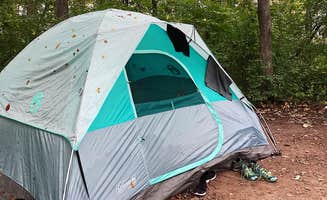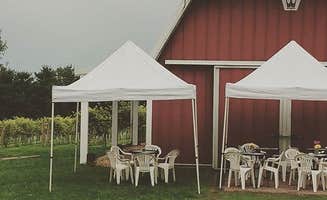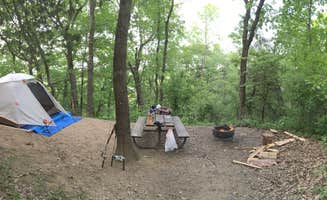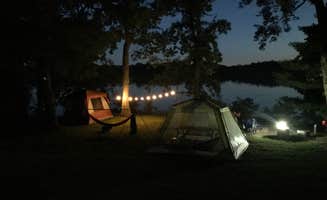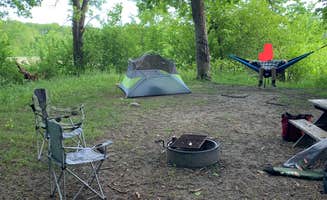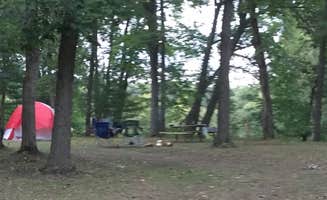Tent camping options around Circle Pines, Minnesota range across more than 14,000 acres of parkland within the surrounding counties. The region features rolling glacial moraines that create varied terrain with elevations between 850 and 1,100 feet above sea level. Summer temperatures typically reach 80-85°F with cooler nights around 60°F, while spring and fall camping seasons can see overnight lows drop into the 40s.
What to do
Hiking trails exploration: At Lake Maria State Park, campers can enjoy multiple trail options through hardwood forest and wetland ecosystems. "This is a great place to see all the various landscapes of the St. Croix River Valley. There are miles of walking and hiking trails throughout the park," notes Jason S. The park features both short and longer routes with varying difficulty levels.
Horseback riding opportunities: Crow Hassan Park Reserve provides extensive trails specifically for equestrians. "This is my all-time favorite park to bring my horse to, and it's her favorite trail too. Seriously, when we head back to our trailer she will stop and refuse to proceed," shares Krista T. The park offers two separate equestrian camping locations with hitching posts and horse-friendly facilities.
Mountain biking networks: Several parks within 30 minutes of Circle Pines feature dedicated mountain biking trails. "The single track trail area first and the parking lot was full of mountain bikers. This newly developed trail is 13.25 miles long, so a nice option close to the city for those who are inclined to adventurous biking," reports Krista T. Trail systems typically include loops for beginners through advanced riders.
What campers like
Secluded backcountry sites: For tent campers seeking privacy, Afton State Park offers walk-in sites that require a short hike. "The hike to the campground is short and grueling. A few of the sites are in wooded areas, but we stayed in one of the prairie sites. The terrain is just hilly enough - and in August - the grass long enough to give the sites a sense of privacy and seclusion," explains Andrew C.
Wildlife viewing opportunities: The diverse ecosystems provide excellent wildlife spotting possibilities. "Savanna Campground is lovely. You can hear frogs all night and we even saw a turtle laying eggs in a different campsite," shares Laura E. Many campers report seeing deer, various bird species, and small mammals throughout their stays.
Natural water features: Many campsites offer access to lakes, rivers or wetlands. "My campsite was perfect. The woods made it very secluded. It was close enough to water and bathrooms so it wasn't bad if you planned," notes Adam P. Water sources range from small ponds to larger recreational lakes and river access points.
What you should know
Seasonal bug considerations: Minnesota's warmer months bring mosquitoes and other insects. "When we pulled up to the parking lot we knew we were in trouble. The black flies were dive bombing the car like a scene from Armageddon," warns Steph H. about her summer experience at Lake Maria State Park. Many campers recommend permethrin-treated clothing and quality repellents, particularly in wooded areas from June through August.
Site reservation timing: Campgrounds fill quickly during peak season. "Weekends have been packed and reservations scarce for months at state parks in Minnesota. Arriving on a Sunday afternoon was a dream—very few people in the campground loop," shares Dani K. Most reservable sites can be booked up to 120 days in advance, with holiday weekends often filling immediately when reservations open.
Variable site privacy: Site spacing differs considerably between campgrounds and specific sites. "If I stayed again, I might try site 121 or 123 since they have more privacy. Sites 98, 110, 111, 112, 113, and 114 are right on the road into the campground with some tree coverage and prairie behind. These do not feel very private at all," notes one camper about specific site recommendations.
Tips for camping with families
Beach access selection: Several parks offer swimming areas suitable for children. "This has an amazing beach. Great Trails. Sweet single track for mountain biking. The best kids park at any campground I've been to," reports Daniel R. about Lake Rebecca Park Reserve. Most beaches lack lifeguards, so parental supervision is required.
Cabin alternatives: For families new to camping or wanting more comfort, several parks offer cabin options. "Camper Cabin (Eastern Bluebird) - Perfect little cabin nestled in the southern half of the park! Screened in porch, heated with electricity, and two double bunk beds!" describes Alison O. about cabin options. Cabins typically cost $65-85 per night and book months in advance.
Trail difficulty considerations: When hiking with children, check trail ratings before setting out. "William O'Brien has a great variety of hiking trails," notes one camper, with many parks offering shorter, easier loops suitable for younger hikers alongside more challenging options for teens and adults.
Tips from RVers
Electric hookup availability: Elm Creek Horse Camp offers basic sites that accommodate both tent and RV camping. "The ground is mostly level—perfect for a tent and a sturdy dog bed," notes Alison O., which also indicates good conditions for smaller RVs. Most designated RV sites in the area require advance reservations.
Water and dump station access: Check specific campground amenities before booking. "Most if not all sites are in the woods from what I could tell so there is a lot of leaves. Good trails and a fun experience," shares Brian K. Many campgrounds offer potable water but may not have full RV hookups or dump stations.
Site leveling requirements: The rolling terrain means some sites require leveling. "The camp site was pretty awesome. Like others said, nice and secluded," one camper reports, but adds "carrying firewood, food, water, gear, on a hilly trail through the woods can become real tough real fast" - indicating the uneven terrain that affects both tent and RV camping.


